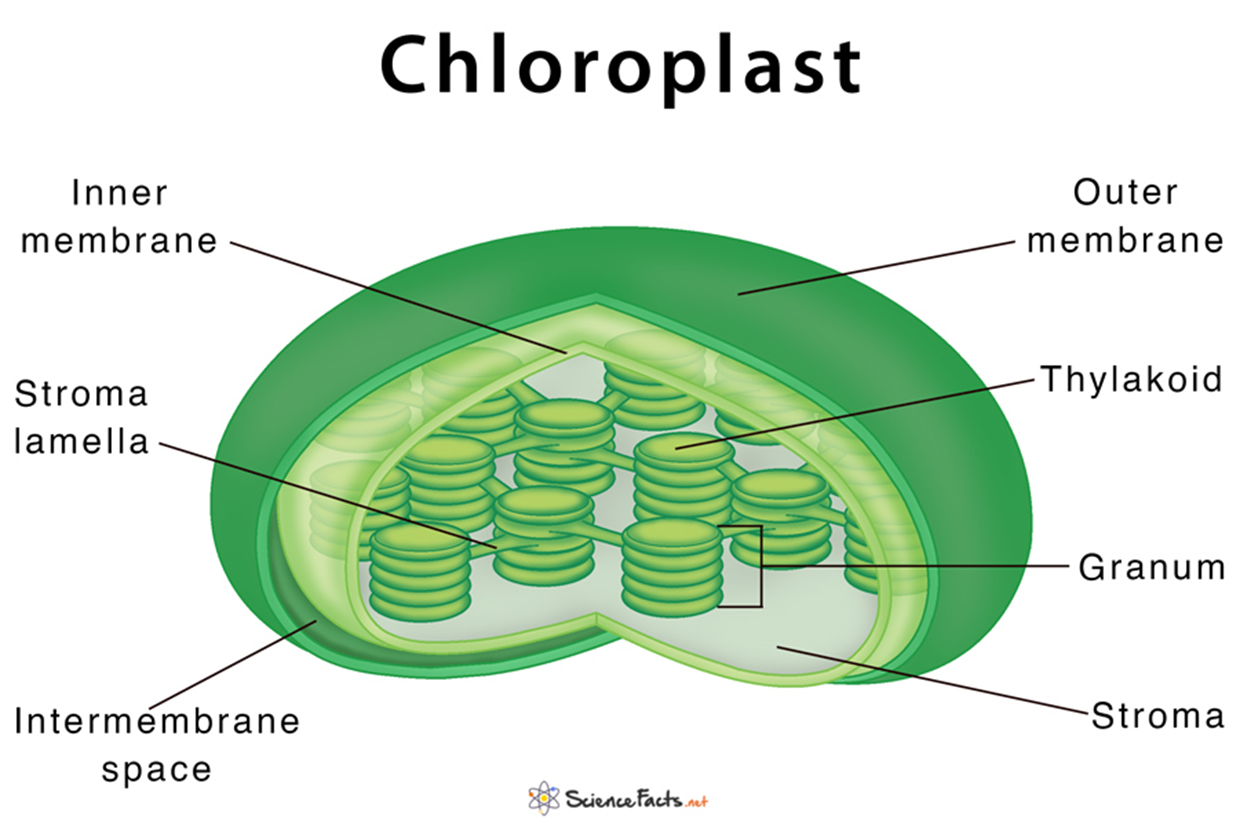3.1-3.8 MULTICELLULAR ORGANISMS
1/87
There's no tags or description
Looks like no tags are added yet.
Name | Mastery | Learn | Test | Matching | Spaced |
|---|
No study sessions yet.
88 Terms
What does sexual reproduction of a eukaryotic organism result in? How is a zygote formed?
Zygote - A fertilised egg cell
The sperm cell fertilises the egg cell
Diploid (2n) full set of chromosomes
Define a gamete
A sex cell
Haploid (n) - half the number of chromosomes i.e. single set of chromosomes
How do cells make up a multicellular organism?
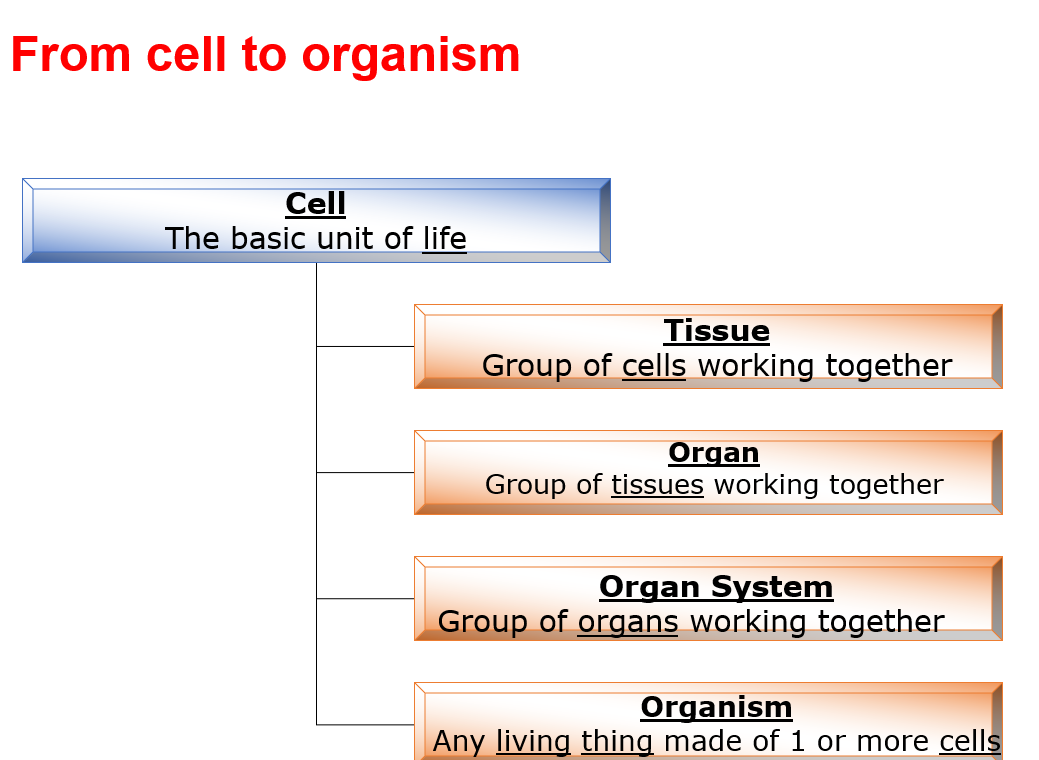
What is cell differentiation?
Cell takes on a specific form and function to become a specialised cell
Cells become specialists at making certain proteins, determining the structure and function of the cell
Explain cell differentiation in terms of a zygote
The zygote undergoes repeated mitotic divisions, rapidly increasing in cell number to form an embryo, EACH CELL GENETICALLY IDENTICAL TO THE OG ZYGOTE
Embryonic cells are unspecialised but contain the genetic material needed to specialise.
As division continues, certain genes in specific cells are activated and others are deactivated, leading to the synthesis of particular proteins.
This process causes cell differentiation, where cells develop unique structures and functions such as muscle and skin cells.
If all cells in a multicellular organism contain identical DNA, how do different cell types develop distinct functions and structures?
The specialised cells express different genes, which code for a specific protein, leading to a unique structure so that they can perform their required function
What is a genome?
A collection of genes in 1 cell of a multicellular organism
What is a gene locus?
The specific location of a gene on a particular chromosome
How are all cells in an organism similar?
They contain identical genetic material (chromosomes and genes)
And certain cell components (cytoplasm, cell membrane, and ribosomes)
How are stem cells, embryo, and a zygote interconnected?
Zygote - single cell formed by fertilisation
Zygote divides to form an embryo
The cells within are embryonic cells
What is the difference between pluripotent and multipotent?
ALL STEM CELLS - but differ in differentiation potential
Pluripotent cells can form any of the cell types in the body
Multipotent cells can only differentiate into a limited number of related cell types
How is gene expression regulated?
Cells control the access that RNA polymerase has to a gene
Transcription factors
Activators: Bind promoter regions, open chromatin, and allow RNA polymerase to access DNA.
Repressors: Bind promoter regions, tighten DNA/histone structure, and block RNA polymerase.
Epigenetic tags
DNA methylation: Adds methyl groups that typically silence a gene by blocking transcription.
Histone modification: Changes to histones (e.g., acetylation loosening DNA, methylation varying by site) alter chromatin structure, controlling gene accessibility.
Difference between a polypeptide and protein?
sequence or chain of amino acids joined together by peptide bonds
POLYPEPTIDE CHAINS MAKE UP PROTEINS
Why is blood considered a connective tissue?
It is a collection of similar specialised cells that are grouped together to perform a specific function.
It connects all organ systems in the body
They derive from the same type of stem cell as other connective tissues.
What are the 4 main types of tissue and an example of each?
Muscle - smooth muscle tissue
Epithelial (lining) - skin epithelium
Connective - blood
Nervous - brain/spinal cord
What is transcription?
1st step of protein synthesis - process of building mRNA
A protein called RNA polymerase binds to DNA near the gene coding for the required protein
RNA polymerase unwinds the DNA double helix to ‘expose’ the nucleotide base sequence of this gene
RNA polymerase moves along the exposed gene to synthesise a mRNA molecule, which is a working copy of the gene that can travel out of the nucleus to be translated in the ribosomes
RNA doesn’t contain thymine - Uracil instead
Explain the process of translation
2nd step of protein synthesis - making the actual protein
Messenger RNA (mRNA) is transported out of the nucleus to ribosomes in the cytoplasm.
Ribosomes movie along the mRNA strand and assemble amino acids in a specific order with the help of transfer RNA (tRNA) molecules, forming a polypeptide
The polypeptide then folds into a precise 3D shape forming a functional protein.
Label the upper respiratory system
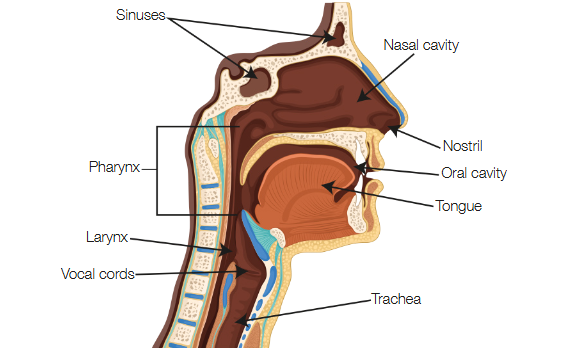
Label the major organs of the respiratory system
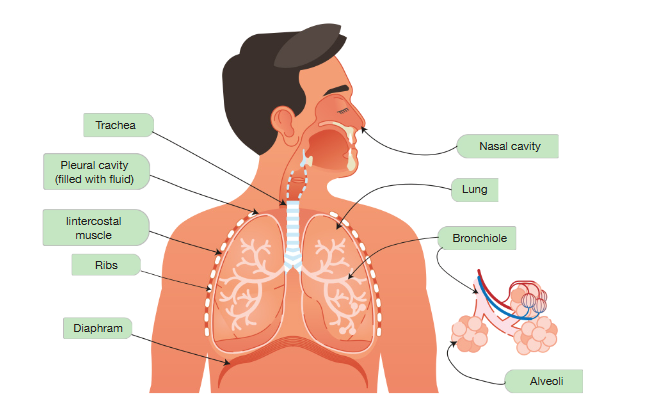
Label the lower respiratory system
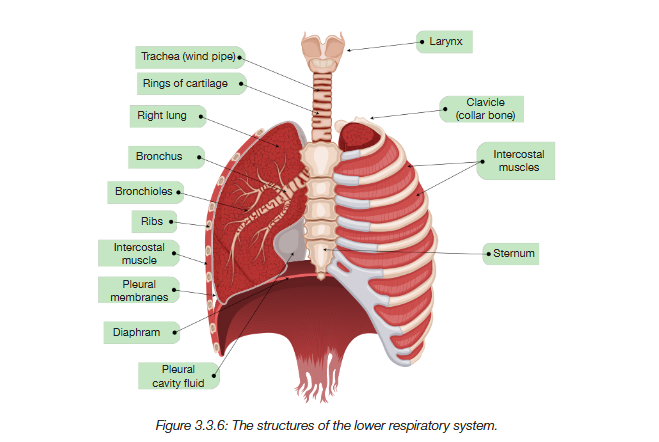
What is a gene promoter?
-Specific DNA sequence located near a gene
-Serves as a binding site for RNA polymerase and other proteins, initiating the process of transcription
What is a gene? What is a mutation?
A unique sequence of DNA nucleotides that code for a specific protein, RNA molecule, or polypeptide chain, that leads to the expression of a particular physical characteristic or trait.
A mutation is any changes to this unique DNA nucleotide sequence (e.g. may change the amino acid sequence and thereby the protein it codes for)
What are the coding and non coding regions of DNA called?
Coding - Exons
Non-coding - Introns
What is DNA?
DNA consists of 2 complementary strands that wind around each other to form double helix
The complementary strands are made of a sugar-phosphate backbone and a specific sequence of DNA bases
The bases form weak hydrogen bonds with its complementary base A-T (2) or C-G (3)
What are the different types of muscle tissue?
Smooth
Skeletal
Cardiac
What is epithelial tissue?
Lines the body surfaces, internal organs, tracts, and cavities
All types are composed of distinctive cells uniform in appearance, stratified (in layers)
What is connective tissue?
Bone, adipose, blood, tendons, ligaments, cartilage
Connective tissue is mainly composed of three components: cells, extracellular fibres (collagen, elastic, reticular), and ground substance (a gel-like matrix) that together form the extracellular matrix.
Mainly binds, supports and protects other tissues
What is nervous tissue?
Nerves, spinal cord, brain
Makes up the nervous system
Senses stimuli and transmits signals from 1 part of the body to another
Its key functional unit is a neuron (nerve cell)
What are the main factors of an efficient exchange surface?
Thin - reduces distance that the materials need to move during exchange
Moist - allows the substances to dissolve in water, assisting their transport across the exchange surface
High SA - provides more surface for exchange to occur
High concentration grad. - directly increases the rate of diffusion, allowing substances to move more quickly across the surface
Rich blood supply - to transport the materials to and from the exchange surface
What are the characteristics of veins, arteries, and capillaries?
Venules - tiny veins that collect oxygen-poor blood from capillaries and deliver it to larger veins, eventually returning it to the heart
Vein - thin, large lumen, valves, low-pressure deoxygenated blood back to the heart - vena cava is the largest
Arteries - thick, small lumen, high pressure oxy. blood away from the heart
Arterioles - blood vessel that branches off from your artery and carries blood away from your heart to your tissues and organs
Capillary - single layer of cells, very small lumen, exchange of materials - where metabolic waste is exchanged between blood/body tissues by diffusion - arteriole end has high conc. of oxy. and nutrients like gluocose - venule end removes waste products from tissues high conc. of CO2 and urea
Explain inhalation
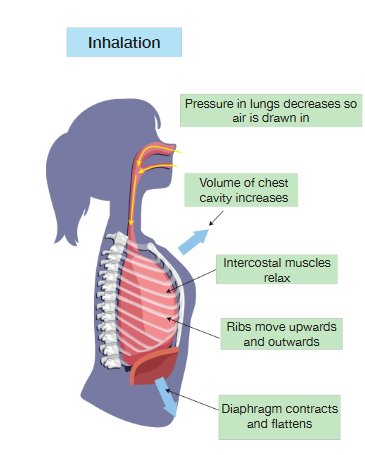
Explain the steps of blood flow through the heart
Deoxygenated blood from the body enters the right atrium through the superior and inferior vena cava.
The right atrium contracts, pushing blood through the tricuspid valve into the right ventricle.
The right ventricle contracts, sending deoxygenated blood through the pulmonary valve into the pulmonary artery, which carries it to the lungs to pick up oxygen.
Oxygenated blood returns from the lungs via the pulmonary veins and enters the left atrium.
The left atrium contracts, pushing blood through the mitral/bicuspid valve into the left ventricle.
The left ventricle contracts strongly, sending oxygenated blood through the aortic valve into the aorta, which delivers it to the entire body.
After blood circulates around the body and loses oxygen, it returns via the vena cava to restart the cycle.
What is the main excretory organ in the body and its functional unit?
Kidneys - nephrons
Explain the structures and function of a nephron?
Glomerulus & Bowman’s capsule
High pressure in the glomerulus forces small molecules (water, salts, glucose, amino acids, vitamins, urea) into Bowman’s capsule.
Proteins and blood cells are too large, so they stay in the blood.
Proximal Convoluted Tubule
Selective reabsorption of useful solutes (glucose, amino acids, salts) into capillaries via diffusion and active transport.
Water - osmosis, maintaining fluid balance.
Loop of Henle
Descending limb: Permeable to water only, so water leaves by osmosis, making the filtrate more concentrated.
Ascending limb: Permeable to salts but not water, so salts are reabsorbed (diffusion then active transport), making the filtrate dilute.
Distal Convoluted Tubule
Helps regulate blood pH
Collecting Duct
Further reabsorption of water under the influence of ADH (antidiuretic hormone).
Remaining filtrate (mainly water, salts, and urea) becomes urine.
Excretion Pathway
Urine flows from collecting ducts → ureter → bladder → urethra, with exit controlled by a sphincter (circular muscle).
Label the kidneys and the excretory system
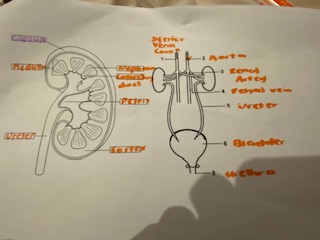
What is osmoregulation?
The hypothalamus detects too little water in the blood
The pituitary gland releases ADH
Kidneys maintain blood water level - open pores in the collecting duct to absorb more water back into the blood
Less water lost in urine - more conc. urine (darker colour)
Blood water level returns to normal level
Why is maintaining an osmotic balance important?
Osmotic balance - correct balance of water and salts in blood at a relatively constant level
Why?
Increase in blood - increases blood pressure - applies extra stress to the circ. system
Chronic high blood pressure increases risk of disorders (e.g. atherosclerosis, heart attacks, heart failure)
What is urea?
Metabolic waste by-product of amino acids that are broken down in liver - removed from blood thru filtration of blood via kidneys
What is a common sign of type 2 diabetes? Explain it.
losing glucose in urine - cloudy urine
Hormonal system has reduced ability to regulate blood glucose due to increased insulin resistance from poor diet and lifestyle choices.
Pancreatic insulin-producing cells decrease in number over time because of:
Inflammation from diets high in saturated fats.
Overstimulation from diets high in simple sugars, leading cells to tire and die off.
Exercise is energy-intensive and lowers blood glucose by burning energy.
Regular exercise promotes fat loss, lowers risk of type 2 diabetes, and improves insulin sensitivity.
A balanced diet low in simple sugars and saturated fats helps prevent insulin resistance.
What are the main functions of the kidney?
4 - filtration reabsorption secretion excretion
What are ADH and dieuretics? What does it do?
Hormone
ADH - increases water absorption in the kidneys - more conc. urine
Die (caffeine, alcohol) - reduce secretion of ADH - decreases water reabsorption - promotes the formation of urine - leads to production of high vol. low conc. urine - leads to dehydration
Continued alcohol consumption - frequent urination - dehydration - hangover symptoms
Define ingestion in terms of the digestive system
food is taken into the body via the act of eating
Define digestion in terms of the digestive system
food is broken down both physically (e.g. mastication) and chemically (e.g. enzymes)
Define absorption in terms of the digestive system
digested food products are absorbed into the bloodstream and transported to cells
Define assimilation in terms of the digestive system
Absorbing nutrients from food and using them to build, repair, and maintain cells/tissues
Define elimination in terms of the digestive system
undigested food residues are egested from the body as semi-solid faeces/stool
What is a double circulation system?
e.g. Humans - 4 chambered heart
Type of closed circ. system
Blood passes through the heart 2 times per circulation
Pulmonary circulation - carries blood to lungs for oxygenation and back to heart
Systemic circulation - carries oxygenated blood to body and and back to the heart
efficiently delivers oxygen and nutrients by ensuring efficient separation of oxygenated and deoxygenated blood, allowing higher pressure and faster transport to cells.
This supports higher metabolic rates and energy demands, making it ideal for active animals like birds and mammals.
What is a single circulation system?
e.g. Fish - 2 chambered heart
Type of closed circ. system
Blood passes through the heart once per circulation - continuous loop
Blood leaves the heart and travels to a respiratory organ (like gills) where it picks up oxygen.
Oxygenated blood then flows to the rest of the body, delivering oxygen and nutrients to cells.
Deoxygenated blood returns directly to the heart to complete the circuit.
Explain histone modification
Epigenetic mechanism
Affects gene activity by chemically altering histone proteins, which in turn influences chromatin structure and DNA accessibility.
2 TYPES:
Acetylation: adds acetyl groups, neutralizing positive charges on histones, loosening chromatin to increase gene expression.
Methylation: adds methyl groups, which can either activate or repress genes depending on the location.
What is DNA methylation?
NOT HISTONE MODIFICATION
Adding a methyl group directly to a DNA base, typically leading to gene silencing by altering the DNA's interaction with proteins and forming a compact, inactive chromatin structure.
What is epigenetic tag and epigenome?
An epigenetic tag is a chemical marker added to DNA or its associated proteins that controls whether genes are turned on or off without changing the DNA sequence itself
The epigenome is the complete set of chemical tags on DNA and proteins in a cell that control gene activity without changing the DNA sequence.
What is the main function of muscle tissue?
produce force and movement by contracting and relaxing
How do unicellular organisms exchange materials, why is this diff to multicellular?
They directly do it with the environment (as they are only made up of 1 cell therefore an already an efficient exchange surface)
Multi - parts of the organism aren’t in direct contact with the environment
What are the main exchange surfaces for kidneys, lungs and the intestines?
Kidneys - nephrons
Lungs - alveoli
Intestines - villi
How does air travel through the respiratory system?
Air inhaled is high in oxygen.
It passes through the trachea, which is a tube that directs air into the right and left bronchi.
Each bronchus leads to a lung and branches into smaller bronchioles.
Bronchioles carry air to the alveoli, tiny sacs where gas exchange occurs.
The diaphragm and intercostal muscles (between the ribs) contract and relax to change lung volume, moving air into and out of the alveoli.
What are alveoli?
The functional unit of the lungs - carbon dioxide is exchanged for oxygen
Clusters of air sacs - arranged this way to max. SA - each alveolus is surrounded by a rich capillary network, vascularised, that maintains a high conc. grad. - good exchange surface factor
As blood flows thru capillaries it comes into close contact with the walls of the alveoli
slightly oily surfactant prevents prevents the alveolar walls from collapsing walls from collapsing and sticking tgt
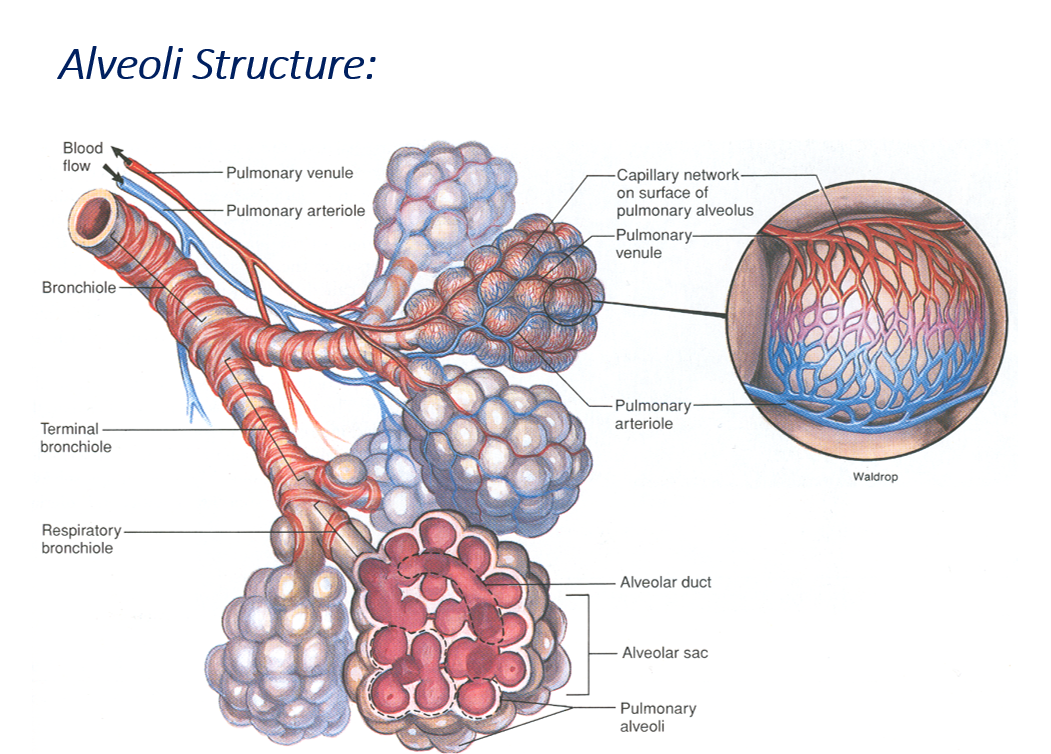
What are the effects of smoking?
ALL TYPES OF SMOKE NOT JS TOBACCO CAN CAUSE CANCERS AND EMPHYSEMA
BOTH ACTIVE AND PASSIVE SMOKING (2nd-hand smoking) CAN LEAD TO LUNG PROBLEMS
Inhaled smoke contains - CO2 affecting the CO2 conc. grad
Carcinogenic chemicals that can trigger tumours
Toxic nicotine that paralyses cilia that normally cleans the lungs and airways
Can lead to emphysema - alveoli become dry and brittle and eventually rupture
What system takes care of the internal transport of materials?
Circ. system
Transport medium - blood - to transport materials thru out the body and remove waste products
Cells require nutrients and waste removal
What is open circulatory system?
Insects have an open circulatory system.
The fluid, called haemolymph, is pumped by a tube-like heart.
The heart has pores called ostia where haemolymph enters.
Haemolymph is pumped through vessels and then into body spaces called sinuses.
Materials are exchanged between haemolymph and cells in these sinuses.
Haemolymph returns to the heart through the ostia to repeat the cycle.
What makes up blood?
Body contains 4-6L blood
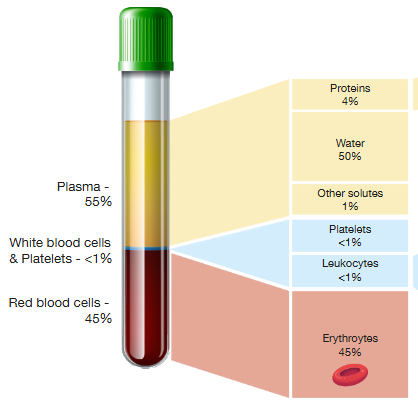
What do platelets do?
Aid blood clotting
Platelets are fragments of other cells
Produce fibrin - sticky network of protein fibres - that form a web - traps blood cells by forming a clot at the site of damage
What do red blood cells do?
RBC - Erythrocytes
Contain haemoglobin - a protein
Haemoglobin binds to O2/CO2 allowing RBC to transport it
Biconcave shape - larger SA - carries more oxygen
Bright red - oxygenated (haemoglobin bound to O2)
Dull dark red - deoxygenated (haemoglobin bound to CO2)
What is the lymphatic system? How does it work with the circulatory system?
The lymphatic system maintains fluid balance by absorbing excess tissue fluid, preventing swelling (oedema).
It helps absorb dietary fats from the intestines.
Made of tiny lymphatic capillaries closed at one end, located throughout the body’s tissues.
Lymph, a clear fluid, flows through larger lymphatic vessels that have valves to prevent backflow.
The lymphatic system works with the circulatory system by returning filtered lymph back into the bloodstream via large lymphatic ducts connected to veins near the heart.
This connection helps maintain blood volume and fluid balance between tissues and the circulatory system.
Explain digestion
Oral cavity: Food is chewed (physical digestion). Salivary glands release saliva containing amylase, which begins breaking down starches into simpler sugars (chemical digestion).
Oesophagus: Moves food to the stomach by muscular contractions (peristalsis - wave-like muscle contractions). No digestion occurs here.
Stomach: Physical digestion: Smooth muscle tissue contracts by peristalsis to churn the food bolus, mixing it with gastric juices into chyme.
Chemical digestion: Gastric glands release pepsins which break down proteins into polypeptides (activated from pepsinogen by stomach acid).
Gastric lipase helps digest fats.
HCL provides the acidic pH required for enzyme activity and activates pepsin to pepsinogen.
Protection: A mucus lining coats the stomach, protecting epithelial cells from the corrosive HCl.
Enzyme activity: The strongly acidic environment also deactivates salivary amylase, so carbohydrate digestion does not continue in the stomach.
Small intestine: The major site of digestion and absorption. It has three sections:
Duodenum – first and smallest section Receives chyme, bile (to emulsify fats), and pancreatic enzymes to break down carbohydrates, proteins, and fats.
Jejunum – Main site for nutrient absorption into the bloodstream.
Ileum – Absorbs remaining nutrients, particularly bile salts and vitamins.
The liver produces bile (stored in the gallbladder) which emulsifies fats, aiding digestion.
Large intestine: Absorbs water and minerals; prepares waste for elimination.
Accessory organs:
BILE IS MECHANICAL DIGESTION
Liver: Produces bile to emulsify fats - physically breaks large fat globules into smaller ones, increasing the surface area for pancreatic lipase.
Gallbladder: Stores and releases bile into the small intestine
Pancreas: Produces enzymes amylase, lipase, and proteases that break down carbohydrates, fats, and proteins.
After digestion:
Rectum and anus: Store and expel solid waste.
What are the enzymes that break down carbs, proteins and lipids?

Pepsin is a specific type of protease enzyme PROTEASE IS THE GENERAL TERM
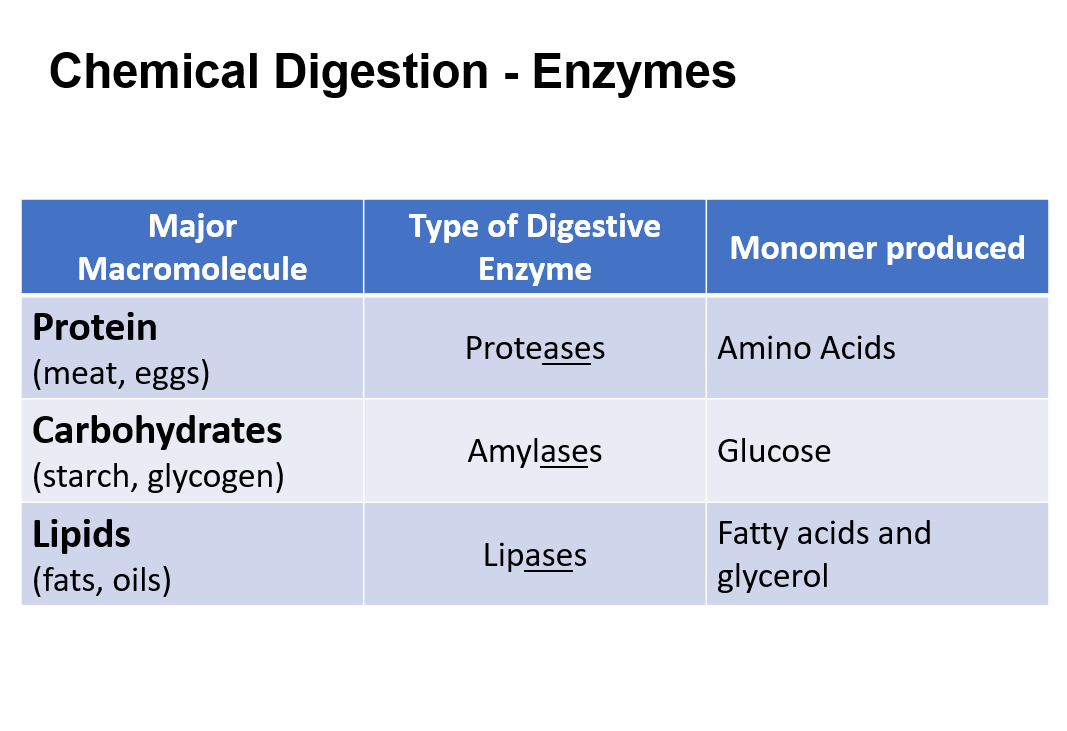
What is a substrate?
Something acted upon by an ezyme
What is the enzyme-substrate complex?
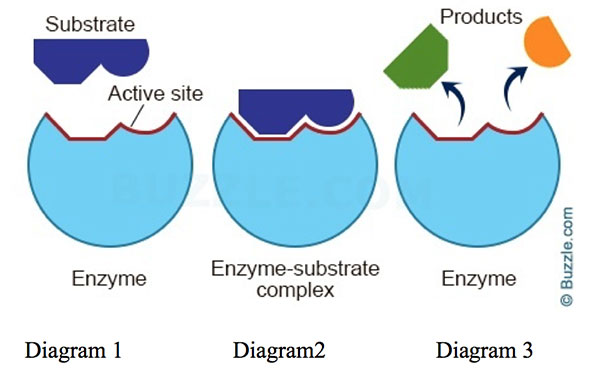
RMBR ACTIVE SITE
Enzyme-substrate complex - lock and key mechanism - shape determines which reaction it speeds up
Enzyme temporarily combines with the substrate that facilitates the substrates conversion into the desired products
What indicates poor kidney function?
Presence of blood/large proteins in urine
What is mRNA and tRNA?
messenger RNA - carries genetic code from DNA to ribosomes
transfer RNA - acts as an adaptor molecule, bringing specific amino acids to the ribosome to be assembled into proteins according to the mRNA's sequence
What are the types of stem cells?

e.g. Bone marrow stem cells differentiating into diff blood cells for adult
Explain hypertension
Hypertension occurs when blood pressure is 140/90 mmHg or higher.
Chronic high blood pressure stiffens and damages artery walls, speeding up atherosclerosis.
If untreated, hypertension can lead to heart failure.
High sodium intake increases hypertension risk because:
Kidneys struggle to excrete excess sodium.
Water is retained to dilute sodium in the blood.
This increases blood volume and blood pressure.
Chronic stress raises blood pressure through stress hormone release, increasing heart rate and pressure.
Regular physical activity lowers blood pressure by strengthening the heart and reducing stress.
Meditation and mindfulness can reduce stress and lower blood pressure.
A diet low in sodium and simple sugars reduces water retention and helps maintain healthy blood pressure.
Explain atherosclerosis
Atherosclerosis is the build-up of fatty deposits (plaques) in arteries.
Plaques thicken artery walls and narrow the channel, reducing blood flow and delivery of nutrients.
Complete blockage can cause a heart attack or stroke.
Diet high in saturated and trans fats raises blood cholesterol, increasing plaque formation risk.
Low fibre intake raises risk, as fibre helps lower cholesterol levels.
Regular exercise:
Increases good cholesterol (HDL), which lowers bad cholesterol (LDL).
Reduces blood pressure, another risk factor for atherosclerosis.
A balanced diet high in plant-based foods, fatty fish (rich in omega-3), and low in saturated/trans fats reduces risk of atherosclerosis.
Explain osteoporosis.
Osteoporosis is a condition causing weak, fragile bones with reduced density.
It develops slowly and may have no symptoms until a bone breaks from minor stress.
Common fractures occur in the hip, wrist, and spine, leading to pain, loss of height, and a stooped posture.
It results from bone losing density faster than it can be rebuilt, creating porous and fragile bone tissue.
Risk factors include a sedentary lifestyle, low calcium and vitamin D intake, insufficient sunlight, menopause, certain medications, smoking, and age.
Weight-bearing exercise is vital for bone development and maintenance.
Vitamin D is necessary to absorb calcium, essential for bone formation.
Diets rich in calcium (dairy or alternatives, dark leafy greens) support bone health.
Osteoporosis can be treated with bone-strengthening medications and prevention efforts focus on lifestyle and diet changes.
What is nervous tissue?
Neurons transmit and receive electro-chemical messages.
Dendrites receive signals, axons carry signals, axon terminals pass them to other neurons.
Myelin sheath insulates axons, speeds transmission, and thickens with frequent use.
What is epigenetics?
The study of how the environment influences gene expression.
What specific tissues are in the brain?

What specific tissues are in the heart?

What specific tissues are in the small intestine?

What is dense fibrous connective tissue?
Made of dense collagen fibres, giving strength and flexibility.
Forms tendons (muscle to bone) and ligaments (bone to bone).
What is simple squamous epithelial tissue?
Single thin layer of flat squamous cells.
Well adapted for gas exchange in alveoli and capillaries due to permeability.
What is ciliated columnar epithelial tissue?
Has cilia (hair-like projections) and goblet cells that secrete mucus.
Traps debris/pathogens in airways and moves them out of the respiratory system.
What is stratified squamous epithelial tissue?
Multiple layers of tightly packed squamous cells.
Forms outer skin (epidermis), protecting against dehydration, pathogens, and damage.
Explain exhalation
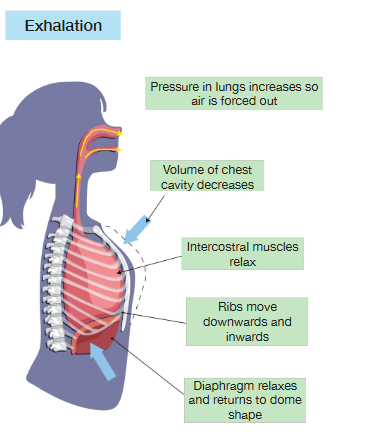
Explain which parts of the heart contain oxygenated and deoxygenated blood. Use arrows to represent the flow of blood through the heart.
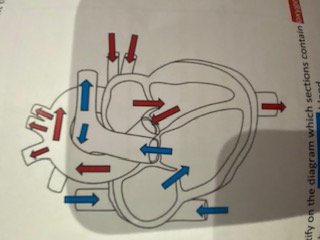
What are the main substances that lymphatic vessels transport?
Proteins
Fats and fatty acids
Extracellular fluid from tissues), which becomes lymph when entering lymphatic vessels
Label a leaf
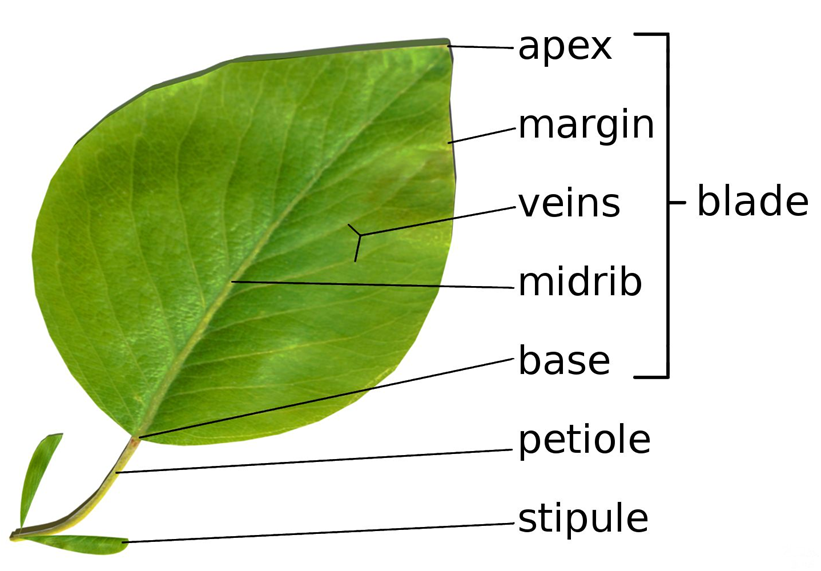
Label a chloroplast
